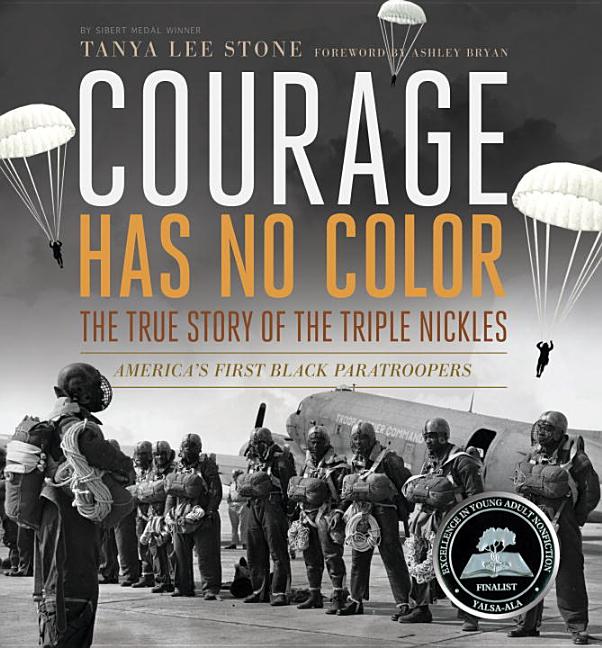Book Descriptions
for Courage Has No Color by Tanya Lee Stone
From Cooperative Children's Book Center (CCBC)
In 1943, Sergeant Walter Morris, a guard at Fort Benning, Georgia, saw how his fellow Black soldiers were struggling with morale. He began leading his men through the ground training exercises he saw the white paratroopers doing. No one had given him permission, but he wanted to prove to them that they were just as capable as white soldiers. Instead of being reprimanded, Morris got official go-ahead for formation of the first Black paratrooper unit, the 555th Parachute Infantry Company. Tanya Lee Stone follows Morris and other soldiers through the first training classes, and their subsequent expectation that the newly minted Triple Nickles would be sent into battle-the war in Europe was raging. Instead, they were sent to fight forest fires in the Pacific Northwest and California as smoke jumpers. A repeated theme in Stone's narrative is how the members of the Triple Nickles had to swallow bitterness over and over. But they did, performing the jobs they were asked to do with distinction because they knew the long road was important. Stone introduces a number of the unit's members, some of whom she interviewed as part of her research. She also provides broader social context for the racism that defined much of the experience of Black soldiers both within and beyond the military during World War II. Her author's note is an informative discussion of her research and decision-making as a writer-the difficulty of gleaning some facts, and the choices she made at certain points as she gained information and insight through reading and first-person interviews. Numerous black-and-white photographs, and detailed source notes, are included. (Ages 12-16)
CCBC Choices 2014. © Cooperative Children's Book Center, Univ. of Wisconsin - Madison, 2014. Used with permission.
From the Publisher
A 2014 YALSA Excellence in Nonfiction Finalist
They became America's first black paratroopers. Why was their story never told? Sibert Medalist Tanya Lee Stone reveals the history of the Triple Nickles during World War II.
World War II is raging, and thousands of American soldiers are fighting overseas against the injustices brought on by Hitler. Back on the home front, the injustice of discrimination against African Americans plays out as much on Main Street as in the military. Enlisted black men are segregated from white soldiers and regularly relegated to service duties. At Fort Benning, Georgia, First Sergeant Walter Morris's men serve as guards at The Parachute School, while the white soldiers prepare to be paratroopers. Morris knows that for his men to be treated like soldiers, they have to train and act like them, but would the military elite and politicians recognize the potential of these men as well as their passion for serving their country? Tanya Lee Stone examines the role of African Americans in the military through the history of the Triple Nickles, America's first black paratroopers, who fought in a little-known attack on the American West by the Japanese. The 555th Parachute Infantry Battalion, in the words of Morris, "proved that the color of a man had nothing to do with his ability."
From Courage Has No Color
What did it take to be a paratrooper in World War II? Specialized training, extreme physical fitness, courage, and — until the 555th Parachute Infantry Battalion (the Triple Nickles) was formed — white skin.
It is 1943. Americans are overseas fighting World War II to help keep the world safe from Adolf Hitler's tyranny, safe from injustice, safe from discrimination. Yet right here at home, people with white skin have rights that people with black skin do not.
What is courage? What is strength? Perhaps it is being ready to fight for your nation even when your nation isn't ready to fight for you.
They became America's first black paratroopers. Why was their story never told? Sibert Medalist Tanya Lee Stone reveals the history of the Triple Nickles during World War II.
World War II is raging, and thousands of American soldiers are fighting overseas against the injustices brought on by Hitler. Back on the home front, the injustice of discrimination against African Americans plays out as much on Main Street as in the military. Enlisted black men are segregated from white soldiers and regularly relegated to service duties. At Fort Benning, Georgia, First Sergeant Walter Morris's men serve as guards at The Parachute School, while the white soldiers prepare to be paratroopers. Morris knows that for his men to be treated like soldiers, they have to train and act like them, but would the military elite and politicians recognize the potential of these men as well as their passion for serving their country? Tanya Lee Stone examines the role of African Americans in the military through the history of the Triple Nickles, America's first black paratroopers, who fought in a little-known attack on the American West by the Japanese. The 555th Parachute Infantry Battalion, in the words of Morris, "proved that the color of a man had nothing to do with his ability."
From Courage Has No Color
What did it take to be a paratrooper in World War II? Specialized training, extreme physical fitness, courage, and — until the 555th Parachute Infantry Battalion (the Triple Nickles) was formed — white skin.
It is 1943. Americans are overseas fighting World War II to help keep the world safe from Adolf Hitler's tyranny, safe from injustice, safe from discrimination. Yet right here at home, people with white skin have rights that people with black skin do not.
What is courage? What is strength? Perhaps it is being ready to fight for your nation even when your nation isn't ready to fight for you.
Publisher description retrieved from Google Books.


